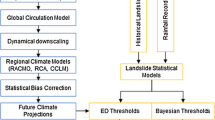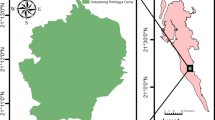Abstract
Rainfall and earthquakes are two major triggers for landslides. To assess annual rainfall-earthquake-induced landslide hazards, an ensemble model containing three modules: an uncertainty-analysis module, a simulation module and an output module was proposed. In the uncertainty-analysis module, the input parameters including the topography (slope, curvature), soil depth, rainfall, peak ground acceleration and soil physical properties were considered probabilistic rather than taking specific values. A rainfall-earthquake-induced landslide hazard assessment was carried out in the simulation module, which used two separate methods: a pseudo-static model and a Newmark displacement model based on probabilistic data, which were prepared in the uncertainty-analysis module using the Monte Carlo simulation technique. In the output module, the two landslide hazard evaluations were combined into one map. The combined landslide hazard provides a range of annual probabilities of landslide occurrence corresponding to specific confidence levels. The proposed model can be used for reliable forecasting at specific confidence levels.
Similar content being viewed by others
References
Ashford SA, Sitar N, Lysmer J, Deng N (1997) Topographic effects on the seismic response of steep slopes. Bulletin of the Seismological Society of America 87(3):701–709
Baecher GB, Christian JT (2005) Reliability and statistics in geotechnical engineering. John Wiley & Sons, Hoboken, NJ, USA
Blake TF, Holingsworth RA, Stewart JP (2002) Recommended procedures for implementation of DMG special publication 117 guidelines for analyzing and mitigating landslide hazards in California. Los Angeles Section Geotechnical Group, Southern California Earthquake Center, Los Angeles, CA, USA
Borga M, Fontana GD, Cazorzi F (2002) Analysis of topographic control on shallow landsliding using a quasi-dynamic wetness index. Journal of Hydrology 268(1–4):56–71, DOI: https://doi.org/10.1016/S0022-1694(02)00118-X
Chough SK, Sohn YK (2010) Tectonic and sedimentary evolution of a Cretaceous continental arc-backarc system in the Korean peninsula: New view. Earth-Science Reviews 101(3–4):225–249, DOI: https://doi.org/10.1016/j.earscirev.2010.05.004
Du W, Wang G (2014) Fully probabilistic seismic displacement analysis of spatially distributed slopes using spatially correlated vector intensity measures. Earthquake Engineering & Structural Dynamics 43(5):661–679
Du W, Wang G (2016) A one-step Newmark displacement model for probabilistic seismic slope displacement hazard analysis. Engineering Geology 205:12–23, DOI: https://doi.org/10.1016/j.enggeo.2016.02.011
Eastman R (1992) Idrisi: A grid-cell based geographic analysis system, Version 4. Graduate Department of Geography, Clark University, Worcester, MA, USA
Ehlschlaeger C (1998) Exploring temporal effects in animations depicting spatial data uncertainty. Association of American Geographers Annual Conference, Boston, MS, USA
Emolo A, Sharma N, Festa G, Zollo A, Convertito V, Park JH, Lim IS (2015) Ground-motion prediction equations for South Korea Peninsula. Bulletin of the Seismological Society of America 105(5): 2625–2640, DOI: https://doi.org/10.1785/0120140296
Faccioli E (1991) Seismic amplification in the presence of geological and topographic irregularities. Second international conference on recent advances in geotechnical earthquake engineering and soil dynamics, March 11–15, Rolla, MO, USA
Fisher PF (1991) First experiments in viewshed uncertainty: The accuracy of the viewshed area. Photogrammetric Engineering & Remote Sensing 57(10):1321–1327
García Rodríguez MJ, Havenith H, Benito Oterino B (2008) Evaluation of earthquake-triggered landslides in El Salvador using a Gis based Newmark model. The 14th world conference on earthquake engineering, October 12–17, Beijing, China
Giardini D (1999) The global seismic hazard assessment program (GSHAP)-1992/1999. Annals of Geophysics 42(6)
Hammitt G M (1966) Statistical analysis of data from a comparative laboratory test program sponsored by ACIL. No. AEWES-Misc Paper-4-785, Army Engineer Waterways Experiment Station Vicksburg Ms Geotechnical Lab, Vicksburg, MS, USA
Haneberg WC (2004) A rational probabilistic method for spatially distributed landslide hazard assessment. Environmental and Engineering Geoscience 10(1):27–43, DOI: https://doi.org/10.2113/10.1.27
Haneberg WC (2006) Effects of digital elevation model errors on spatially distributed seismic slope stability calculations: An example from seattle. Washington William C. Haneberg, Haneberg Geoscience. Environmental & Enginnering Geoscience XII(3):1–35, DOI: https://doi.org/10.2113/gseegeosci.12.3.247
Haneberg WC (2008) Elevation errors in a LIDAR digital elevation model of West Seattle and their effects on slope-stability calculations. Reviews in Engineering Geology 20:55–65, DOI: https://doi.org/10.1130/2008.4020(03)
Holmes K Chadwick O, Kyriakidis P (2000) Error in a WSGS 30m DEM and its impact on terrain modeling. Journal of Hydrology 233(1–4):154–173, DOI: https://doi.org/10.1016/S0022-1694(00)00229-8
Hsieh YC, Chan YC, Hu JC (2016) Digital elevation model differencing and error estimation from multiple sources: A case study from the Meiyuan Shan landslide in Taiwan. Remote Sensing 8(3), DOI: https://doi.org/10.3390/rs8030199
Hunter GJ, Goodchild MF (2010) Modeling the uncertainty of slope and aspect estimates derived from spatial databases. Geographical Analysis 29(1):35–49, DOI: https://doi.org/10.1111/j.1538-4632.1997.tb00944.x
Hynes-Griffin M E, Franklin A G (1984) Rationalizing the seismic coefficient method. No. WES/MP/GL-84-13, Army Engineer Waterways Experiment Station Vicksburg Ms Geotechnical Lab, Vicksburg, MS, USA
Iida T (1984) A hydrological method of estimation of the topographic effect on the saturated throughflow. Japanese Geomorphological Union 5(1):1–12
Jeong S, Kim Y, Lee JK, Kim J (2015) The 27 July 2011 debris flows at Umyeonsan, Seoul, Korea. Landslides 12(4):799–813, DOI: https://doi.org/10.1007/s10346-015-0595-0
Jibson RW (1993) Predicting earthquake-induced landslide displacements using Newmark’s sliding block analysis. Transportation Research Record 1411(1411):9–17
Jibson RW (2007) Regression models for estimating coseismic landslide displacement. Engineering Geology 91(2–4):209–218, DOI: https://doi.org/10.1016/j.enggeo.2007.01.013
Jibson RW (2009) Using landslides for paleoseismic analysis. Paleoseismology 95(9):565–601, DOI: https://doi.org/10.1016/S0074-6142(09)95008-2
Jibson RW (2011) Methods for assessing the stability of slopes during earthquakes — A retrospective. Engineering Geology 122(1–2):43–50, DOI: https://doi.org/10.1016/j.enggeo.2010.09.017
Jibson RW (2014) Mapping seismic landslide hazards in Anchorage, Alaska. Proceedings of the 10th national conference in earthquake engineering, July 21–25, Anchorage, AK, USA
Jibson RW, Harp EL, Michael JA (2000) A method for producing digital probabilistic seismic landslide hazard maps. Engineering Geology 58(3–4):271–289
Jibson RW, Keefer DK (1993) Analysis of the seismic origin of landslides: Examples from the New Madrid seismic zone. Geological Society of America Bulletin 105(April):521–536, DOI: https://doi.org/10.1130/0016-7606(1993)105<0521:AOTSOO>2.3.CO;2
Jibson RW, Michael JA (2009) Maps showing seismic landslide hazards in Anchorage, Alaska. US Geological Survey, 3077, Reston, VA, USA
Keefer DK, Wilson RC (1989) Predicting earthquake-induced landslides, with emphasis on arid and semi-arid environments. Landslides in a semi-arid environment 2(Part 1):118–149
Kim HS, Chung CK (2016) Development and application of gis-based information system of landslide hazard map induced by Earthquakes and rainfall in Korea. GISTAM 2016 — Proceedings of the 2nd international conference on geographical information systems theory, April 26–27, Rome, Italy, 227–234
Kulhawy F H, Phoon K K, Prakoso W A, Hirany A (2007) Reliability-based design of foundations for transmission line structures. In: Electrical Transmission Line and Substation Structures: Structural Reliability in a Changing World, ASCE, Reston, VA, USA, 184–194
Kyung J-B, Kim M-J, Lee S-J, Kim J-K (2016) An analysis of probabilistic seismic hazard in the Korean Peninsula. Journal of the Korean Earth Science Society 37(1):52–61, DOI: https://doi.org/10.5467/jkess.2016.37.1.52
Lacasse S and Nadim F (1996) Uncertainties in characterizing soil properties. In: Uncertainty in the Geologic Environment: From Theory to Practice, ASCE, Reston, VA, USA, 58:49–75
Lee J, Han J-T, Baek Y, Park D, Lee J, Park I-J (2014) Development of prediction method considering geometrical amplification characteristics of slope II: Construction of landslide hazard map during earthquakes in Seoul. Journal of Korean Society of Hazard Mitigation 14(5):85–92, DOI: https://doi.org/10.9798/kosham.2014.14.5.85
Leemis L, Harr ME (2006) Reliability-based design in civil engineering. Technometrics 31(1):126, DOI: https://doi.org/10.2307/1270385
Liu J, Gao M, Wu S, Wang T, Wu J (2016) A hazard assessment Method for potential earthquake-induced landslides — A case study in huaxian county, shaanxi province. Acta Geologica Sinica 90(2): 590–603, DOI: https://doi.org/10.1111/1755-6724.12693
López C (1997) Locating some types of random errors in digital I introduction? International Journal 11(1987):1–16
Marcuson WF (1981) Moderator’s report for session on “Earth dams and stability of slopes under dynamic loads.” In: International Conference on Recent Advances in Geotechnical Earthquake Engineering and Soil Dynamics, University of Missouri, Columbia, MO, USA, 3:1175
Mudron I, Cirbus J, Podhoranyi M, Bobal P, Devecka B and Bakay L (2012) Elevation error modelling and propagation in slope estimation: A case study from Olse and Stonavka confluence area, Czech Republic. Report the IT4Innovations Centre of Excellence Project
Newmark NM (1965) Effects of earthquakes on dams and embankments. Géotechnique 15(2):139–160, DOI: https://doi.org/10.1680/geot.1965.15.2.139
Pradhan AMS, Kim Y-T (2017) Spatio-temporal landslide hazard mapping using coupled hydrological model in Mt. umyeon, Seoul. Landscape Architecture and Regional Planning 2(3):83
Refice A, Capolongo D (2002) Probabilistic modeling of uncertainties in earthquake-induced landslide hazard assessment. Computers & Geosciences 28:735–749, DOI: https://doi.org/10.1016/S0098-3004(01)00104-2
Rodríguez-Peces MJ, García-Mayordomo J, Azañón JM, Jabaloy A (2014) GIS application for regional assessment of seismically induced slope failures in the Sierra Nevada Range, South Spain, along the Padul Fault. Environmental Earth Sciences 72(7):2423–2435, DOI: https://doi.org/10.1007/s12665-014-3151-7
Saulnier G-M, Beven K, Obled, C (1997) Including spatially variable soil depth in TOPMODEL. Journal of Hydrology 202(1–4):158–172, DOI: https://doi.org/10.1016/S0022-1694(97)00059-0
Schultze E (1971) Frequency distributions and correlations of soil properties. Proceedings of 1st International Conference on Applications of Statistics and Probability in Soil and Structural Engineering, Hong Kong University Press, Hong Kong, China, 371–387
Seed HB (1979) Considerations in the earthquake-resistant design of earth and rockfill dams. Géotechnique 29(3):215–263, DOI: https://doi.org/10.1680/geot.1979.29.3.215
Seoul Institution (2014) Final report on the cause of landslides in Umyeonsan (Mt.) — Complementary investigation, Report No. 51-6110000-000649-01, The Seoul Institute, Seoul, Korea
Shedlock KM., Giardini D, Grunthal G, Zhang P (2011) The GSHAP global seismic hazard map. Seismological Research Letters 71(6): 679–686, DOI: https://doi.org/10.1785/gssrl.71.6.679
Terzaghi K (1950). Mechanism of landslides — Application of geology to engineering practice. Geological Society of America, 83–123
Travasarou T, Bray JD, Abrahamson NA (2003) Empirical attenuation relationship for Arias Intensity — Example application. Informal Note 32(7):1–4
Vanmarcke EH (2005) Probabilistic modeling of soil profiles. International Journal of Rock Mechanics and Mining Sciences & Geomechanics Abstracts 15(3):49, DOI: https://doi.org/10.1016/0148-9062(78)90012-8
Varnes, D. J. (1984) Landslide hazard zonation: A review of principles and practice. United Nations, New York, NY, USA, 3:61
Veregin H (2008) The effects of vertical error in digital elevation models on the determination of flow-path direction. Cartography and Geographic Information Systems 24(2):67–79, DOI: https://doi.org/10.1559/152304097782439330
Wang G, Du C, Huang D, Jin F, Koo RC, Kwan JS (2018) Parametric models for 3D topographic amplification of ground motions considering subsurface soils. Soil Dynamics and Earthquake Engineering 115:41–54
Wechsler SP (1999) Digital elevation model (DEM) uncertainty: Evaluation and effect on topographic parameters. In: ESRI User Conference, San Diego, CA, USA, 1081–1090
Wechsler SP, Kroll CN (2006) Quantifying DEM uncertainty and its effect on topographic parameters. Photogrammetric Engineering & Remote Sensing 72(9):1081–1090, DOI: https://doi.org/10.14358/PERS.72.9.1081
Widayati A, Lusiana B, Suyamto D, Verbist B (2004) Uncertainty and effects of resolution of digital elevation model and its derived features: Case study of Sumberjaya. The International Archives of the Photogrammetry Remote Sensing, Sumatera, Indonesia
Wieczorek GF, Wilson RC, Harp EL (1985) Map showing slope stability during earthquakes in San Mateo County, California. No. 1257-E, US Geological Survey, Reston, VA, USA
Wolf JP (1994) Foundation vibration analysis using simple physical models, Pearson Education, London, UK
Zolfaghari A, Heath AC (2008) A GIS application for assessing landslide hazard over a large area. Computers and Geotechnics 35(2):278–285, DOI: https://doi.org/10.1016/j.compgeo.2007.03.007
Acknowledgements
This research was supported by a basic research grant from the National Research Foundation of Korea (NRF), funded by the Ministry of Education, Science and Technology (grant no. 2018R1D1A1B07049360), and by funding from the National Research Foundation of Korea (NRF) (grant no. 2018R1A4A 1025765) and the Brain Korea 21 Plus (BK 21 Plus) initiative.
Author information
Authors and Affiliations
Corresponding author
Rights and permissions
About this article
Cite this article
Nguyen, V.BQ., Kim, YT. Rainfall-Earthquake-Induced Landslide Hazard Prediction by Monte Carlo Simulation: A Case Study of MT. Umyeon in Korea. KSCE J Civ Eng 24, 73–86 (2020). https://doi.org/10.1007/s12205-020-0963-8
Received:
Revised:
Accepted:
Published:
Issue Date:
DOI: https://doi.org/10.1007/s12205-020-0963-8




